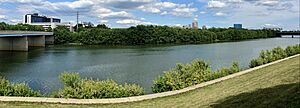Lilly ARBOR Project facts for kids
The Lilly ARBOR Project is a special program in Indianapolis, Indiana, USA. It helps bring back forests along the White River. ARBOR is a short way of saying "Answers for Restoring the Bank Of the River". This project is all about planting trees and making the riverbanks healthy again. It's an experimental program for restoring riparian floodplain forests.
What is the Lilly ARBOR Project?
This project helps restore forests along riverbanks. It was created by the Center for Earth and Environmental Science (CEES) at Indiana University–Purdue University Indianapolis (IUPUI). The Lilly Endowment provided support to make it happen.
Nearly 1,400 trees were planted along the eastern side of the White River. This area is close to downtown Indianapolis. The project site is about eight-acre (3.2 ha) big. It stretches for about one mile (1.6 km) from 10th Street to New York Street. The first trees were planted in the fall of 1999 and the spring of 2000.
After five years, the Lilly ARBOR Project collected important information. This data helps scientists learn the best ways to replant trees along rivers. This information is used for new research and future projects. Students and teachers from different universities help with the research. They also help take care of the restored area through the CEES service learning program.
What Trees Grow Here?
A total of 1,332 trees were planted when the project started. These trees belonged to twelve different types of native species. Native species are plants that naturally grow in an area.
Here are some of the trees planted:
| Scientific name | Common name |
|---|---|
| Acer rubrum | Red maple |
| Acer saccharinum | Silver maple |
| Aesculus glabra | Ohio buckeye |
| Celtis occidentalis | Hackberry |
| Crataegus | Hawthorn |
| Fraxinus pennsylvanica | Green ash |
| Gleditsia triacanthos | Honey locust |
| Platanus occidentalis | American sycamore |
| Populus deltoides | Eastern cottonwood |
| Quercus bicolor | Swamp white oak |
| Quercus muehlenbergii | Chinquapin oak |
| Salix nigra | Black willow |
| Source: Indiana University Center for Earth and Environmental Science | |
Since the first trees were planted, other types of trees have started growing there too. Some are native, meaning they belong in the area. Others are invasive, which means they are not from the area and can sometimes harm native plants.
Some of these new trees include:
- American elm (Ulmus americana)
- Box elder (Acer negundo)
- Callery pear (Pyrus calleryana)
- Catalpa
- Dogwood (Cornus)
- Goldenrain tree (Koelreuteria paniculata)
- Red mulberry (Morus rubra)
- White mulberry (Morus alba)
- Siberian elm (Ulmus pumila)
See also
- Ecological restoration
- Buffer strip
- Riparian buffer
- Erosion control
- Riparian zone restoration
- Stream restoration
- Riparian terminology
- Biodiversity
- Conservation biology
- Global warming
- Habitat
- Habitat conservation
- Natural environment
- Plant community


